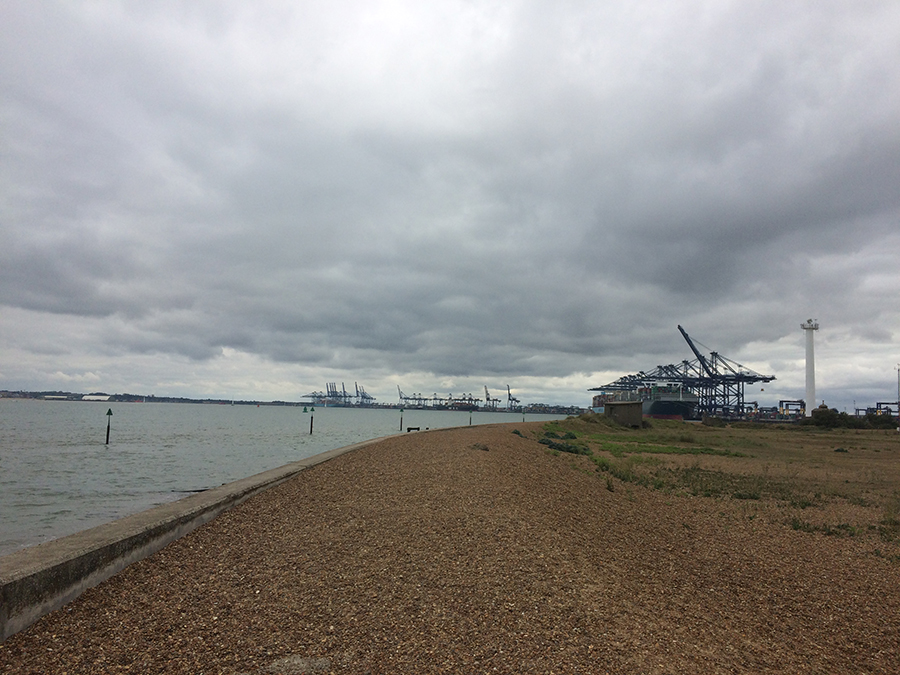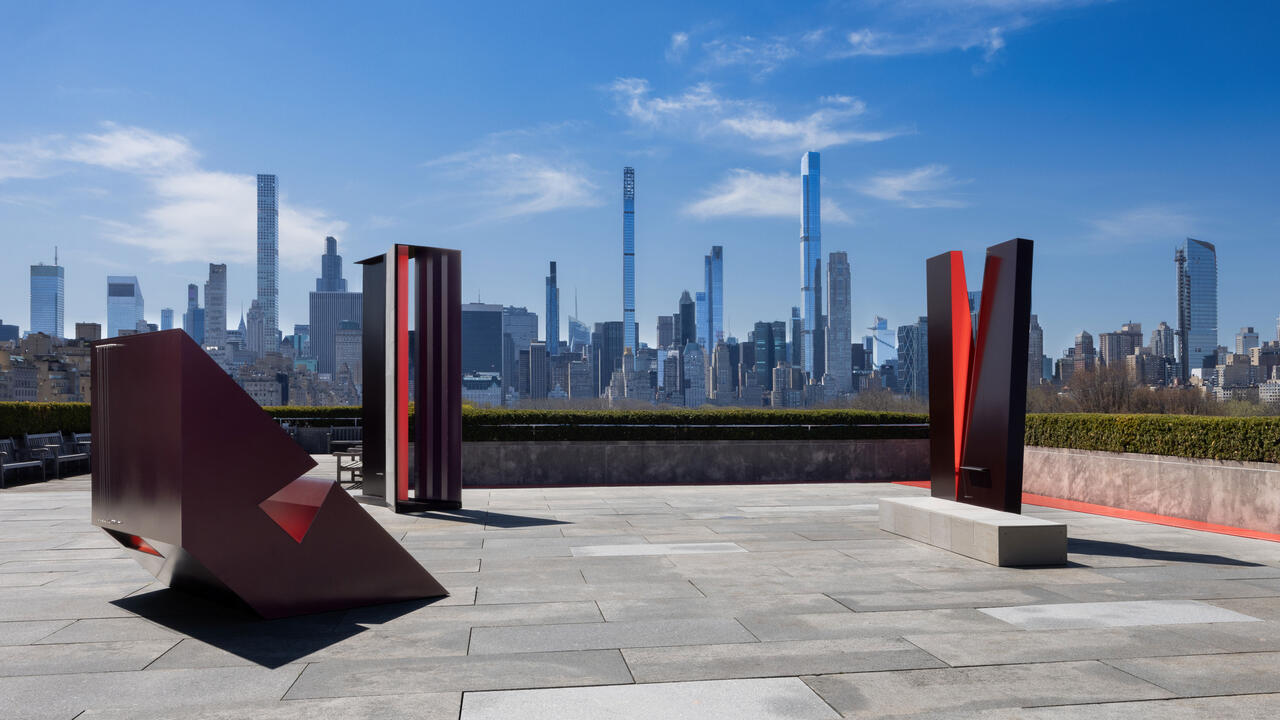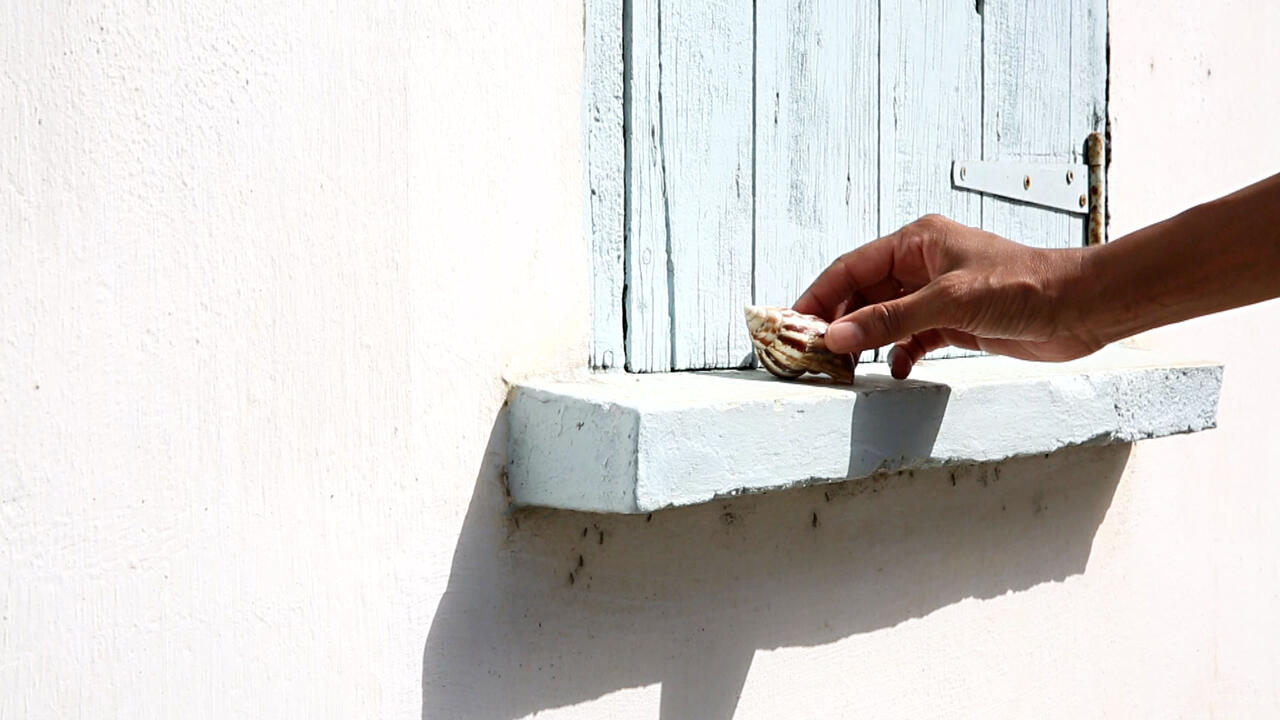Retracing Mark Fisher and Justin Barton’s Eerie Pilgrimage
In 2006, the theorist of ‘hauntology’ and sound-artist walked across the Suffolk coastline – Adam Harper follows in their footsteps, sifting through encrusted layers of history
In 2006, the theorist of ‘hauntology’ and sound-artist walked across the Suffolk coastline – Adam Harper follows in their footsteps, sifting through encrusted layers of history

A bus, an overpriced train, a rail replacement bus service, and I’m on the coast of Suffolk, England, whose ‘fictional and cultural richness,’ according to cultural theorist Mark Fisher, ‘is so dense that one could not exhaust it in a lifetime.’ Having lived in Suffolk, Fisher died in 2017 to the intense dismay of the growing network of writers and scholars he had fostered and inspired for over a decade through his blog K-punk. He’s most famous for his conception of ‘capitalist realism’ in a 2009 book of the same name, describing the pernicious common sense that has reigned since the end of the 20th century: that there is no alternative to capitalism, and that as a result, the better future, long dreamed of, has been cancelled. But I am in Suffolk, sifting through its encrusted layers of history, in pursuit of another (albeit related) topic that Fisher popularized and discussed so well. Under the thumb of capitalist realism, the lost promise of the past is experienced as ‘hauntology’, the spectral insistence that there is something beyond common sense that has been denied, its absent presence by turns inspiring and disturbing.
Experiencing it either in new works of music, art and the moving image, or in a communion with the ancient and almost-lost, Fisher explored this atmosphere on his blog and in his books Ghosts of My Life (2014) and The Weird and the Eerie (2017). In 2013, Fisher and sound-artist Justin Barton created an audio essay modelled on a 2006 walk through coastal Suffolk from the port and seaside town of Felixstowe to the inland Anglo-Saxon burial grounds at Sutton Hoo. In it, washes of unquiet ambient sound accompany voices relaying the features seen by the pair (referred to only as ‘they’), the transitions in the landscape they record, and the cultural resonances they note, going back through 1960s television and literature, World War II, turn-of-the-century ghost stories, the time of the kings of East Anglia, and pre-history. This audio essay, On Vanishing Land (2013), recently became the first release on Flatlines, a sub-label of Hyperdub, which was founded by DJ, producer and Fisher’s fellow theorist Steve Goodman (a.k.a Kode9) and has been celebrated for its relation to the nascence of dubstep and the melancholically grainy rave reminiscences of Burial. The new release offers vinyl, photographs by Mark Fisher, and a text by Justin Barton.
Fisher and Barton’s visit to Suffolk fell on an uncharacteristically summery day in April – mine is an unseasonably downcast July day, skies steaming with stroppy clouds and a wind blowing oddly hot and cold. With Fisher and Barton having conducted On Vanishing Land’s journey in a spirit of cultural archaeology, psychogeography, even pilgrimage, it only made sense that I should go myself. Fisher and Barton went there to encounter the traces of bygone eras and to meditate on the entropy visited upon them as they are carried into the present and the future. Now their sonic document is itself one more layer of Suffolk’s hauntology, and not least the voice of Fisher himself within it.

As Fisher wrote on his blog, ‘Suffolk has always been fighting two wars’. Coastal defence has two meanings along its shoreline: the war of land and sea, with wooden and granite groynes jutting across the sand and shingle beaches in a bid to temporarily slow erosion, and the threat of invasion from across the sea, in the form of the Martello towers that appear every mile in readiness for Napoleon, or the now-crumbling concrete bunkers and pillboxes hastily erected to fend off a possible German invasion during World War II. The many possible worlds along Suffolk’s coast are perhaps most sharply contrasted at the aptly named Landguard Point. Here, on a strange peninsula of shingle dotted with clumps of grey-green sea kale and a handful of pillboxes, is Landguard Fort, where, as Fisher wrote, ‘four centuries of military history are compacted into [an] architectural palimpsest.’ In On Vanishing Land, Fisher and Barton note that it was here that prototype mines were first launched into the ocean.
Today the area is dominated by the enormous machinery of the Port of Felixstowe just across the water, where shipping containers are loaded and unloaded onto vast floating platforms. Fisher and Barton call it a ‘nerve ganglion of capitalism’, and see its image as a blatant revelation of the ‘gigantic infrastructure’ behind the ‘reality blocking addictions’ of postmodern consumer culture. It represents an abundantly successful invasion of the Suffolk seascape: they liken the cranes to ‘H.G. Wells’ tripods’, and read the names on the containers as ‘a kind of accidental window into the results of an entirely successful seizure of power.’

A voice, one of three interviews in On Vanishing Land, describes the disorienting effect of looking at the featureless sea from the deck of a container ship. Standing between one of many shapeless concrete structures and a radar tower rhythmically marking the occupants of time and space as it spins, I watch a speck of a metal box belonging to the Taiwanese Evergreen Marine Corporation lifted from a ship and set down on the land with a boom that is still loud from a mile away. Later that day, alone on the shingle miles north along the coastline and looking out to sea, I watch the moment two container ships – one incoming, one outgoing – meet on the horizon and merge. In one of On Vanishing Land’s highlights, Fisher and Barton imagine the port in an undefined future epoch – desolate, rusting and reclaimed by the hardy vegetation.
The walk heads northeast along the coast, through the town of Felixstowe, a seaside resort from an age when air travel wasn’t yet soaking up the holidaying ambitions of the wealthy. Today it smells of sweetness and batter, and rows of painted beach huts squabble over a thin strip of the colour palette between light blue, teal and aquamarine. Groynes of many different materials and ages punctuate the shore, the most striking of which can be found at Cobbolds Point and on the cover of On Vanishing Land: long buttresses made up from the repeated form of a single polyhedron curving as they approach the horizon, a hard-edged minimalist installation that makes Robert Smithson’s Spiral Jetty (1970) look like kitsch.

Literature is referred to throughout On Vanishing Land, including Joan Lindsay’s Picnic at Hanging Rock (1967), and L. P. Hartley’s The Go-Between (1953) – Fisher remained unmoved by W. G. Sebald’s famous literary exploration of the area in The Rings of Saturn (1995), calling it ‘mittel-brow’ and dreaming of ‘one day producing a pulp modernist riposte’ to it. But a particular touchstone is the writing of M. R. James. As Fisher and Barton note, although renamed ‘Burnstow,’ Felixstowe is the inspiration for one of James’s most famous ghost stories, 1904’s ‘Oh, Whistle, and I’ll Come To You, My Lad’. Fisher wrote on his blog in 2007 that ‘James’ characters are urban scholars who under-estimate the powers of this archaic and arcane terrain, with its ancient lore and laws, at their peril. They come from populous human centres into spaces that human beings have never managed to subdue.’ Enjoying this interpretation but slightly disconcerted by the way the same could be said of me, I listened to a reading of it on the outbound train, having first encountered and read the story more than a decade ago as a result of Fisher’s writing. James’s protagonist discovers a whistle in an ancient grave, and, nonchalantly blowing it, inadvertently summons an entity that makes itself a body from the sheeting of the urban scholar’s hotel bedroom, chasing him first across the groynes in his dreams and then, at the story’s climax, in the waking moonlight.
Fisher and Burton mention watching Jonathan Miller’s 1968 TV adaptation of the story before their walk, so I did too. This time the urban scholar finds the whistle in a clifftop grave whose contents had been newly exposed by coastal erosion, which has long happened to graveyards in the area. In fact, as Fisher and Barton reflect, an entire city further along the Suffolk coast, Dunwich, was swept away during a series of storms in the Middle Ages, its ruins inspiring Romantics and Gothicists such as James hundreds of years later. But the 1968 TV adaptation is, as Fisher would say, downright ‘popular modernist’: long, almost vacant shots of a logician bumbling pathetically through his narrow relations with both other human beings and his environment, with all its historical and transcendental weight. Fisher was fascinated by horror and science fiction on British TV in the 1960s and 1970s, which to the tastes of today’s mainstream can often appear much too weird and frightening, as if previous generations of cultural actors knew rather more about the outer limits of the human soul than the smug retro-culture of today (Fisher’s sense of the weirdness of past horror was the polar opposite of that cultivated by Netflix’s Stranger Things, 2016-ongoing, for example).
Miller’s Whistle and I’ll Come To You is a particularly stark example of this and, having assumed I was an old hand at hauntological aesthetics, it genuinely unsettled me. The length and scant meaningfulness of the shots, and the sudden moments of terror founded upon outrageously crude audiovisual effects – both are borne with such intense conviction that it is as if the very medium of television itself is collapsing into a dream state. The final shot, and the performance it contains, is absolutely shattering, and repeated itself at the back of my mind throughout the following day as I searched the windows of Victorian seafront hotels for a ‘face of crumpled linen.’

Fisher and Barton pass Bawdsey Manor, which, during the 1930s as RAF Bawdsey, saw the development of radar and the stationing of the Women’s Auxiliary Air Force, and reflect on the feminist implications of this ‘place of relative social freedom.’ They note that radar is, like M. R. James’s whistle and indeed any hauntological inquiry, ‘a becoming-active in relation to the unknown […] send a few clicks into the unknown, see what comes back.’ The pair then turn north-west into the countryside, passing villages, farmland, woodland, and eventually heathland as they join the Sandlings Walk trail. After the coastline’s antagonism of concrete, shingle and saltwater, Sutton Heath is a bizarre assemblage of a completely different sort: a fauvist fever dream of blues, purples and browns that my phone’s camera simply cannot capture. Amid it all is an unmanned sewage treatment works Fisher and Burton passed, emitting a complex drone of pitches undulating at different rates – though this particular incursion of machine formalism is the exception here. Radar and Martello towers are replaced by rows of twisted Scots pines, a signature of this landscape, and here the history gets even deeper as the mounds begin appearing. This culminates at Sutton Hoo, where mounds were excavated in 1939, uncovering what was soon called ‘Britain’s Tutankhamun.’
At Sutton Hoo, a ship was buried, entombing someone the surrounding finery implies was an especially important figure – most probably king Rædwald of East Anglia, who died around the year 624. The famous image to emerge from the excavation is the Sutton Hoo Helmet, with its cheek guards and face mask; it adorns the entrance to the National Trust site there today. It is the unlikely visage of an Anglo-Saxon cyborg, coating the body in metal and myth, a casing of and for the jealous human mind: new eyebrows, a new nose, all simulacrum except the eyeholes emptily staring into the distant future. Yet the helmet was discovered in fragments, more than 500 of them – it was smashed when the roof of the burial chamber collapsed at some point down the centuries, and had to be painstakingly but imperfectly reconstructed.

Reconstructions occur to this day at Sutton Hoo. I wonder what Fisher would have made of the breezily hauntological signoff of the National Trust’s ‘Introduction to Sutton Hoo’ website: ‘today, visit Sutton Hoo to walk in the footsteps of our ancestors, and feel the atmosphere of a site on the border between worlds.’ On the day I visit, the Sae Wylfings Anglo-Saxon re-enactment group are there, complete with tunics and shields. A Rick Kirby sculpture representing the Sutton Hoo helmet is there too, nearly two metres high, made up of steel plates like rows of pixels but, echoing the fragmentation of the original find, leaving holes where data was corrupted by time. In fact, archaeologists aren’t entirely sure there was actually a body inside the Sutton Hoo ship burial – if there ever was, it has vanished, leaving only an ambiguous chemical stain.
Reconstruction is seductive, but ultimately impossible. Listening to On Vanishing Land is to reconstruct it in the mind’s eye. My attempt to follow its route and repeat the experience was more physical. But that, too, proved harder than I had anticipated. Over a decade has passed since Fisher and Barton’s walk – properties have changed hands, fields host new crops, and of course the coast has been further washed away. Fisher and Burton found a pillbox near Bawdsey Manor, ‘perched precariously on the cliff’s edge’, likening it to the eroded grave of Miller’s Whistle and I’ll Come to You and predicting that ‘before long, the cliff here will collapse, and the Second World War concrete will fall to the beach.’ When I pass by, this has happened – the structure has cracked into pieces and partially subsided into the sand.

For all their historicity, both the Suffolk landscape and On Vanishing Land are (re)constructions – are fictional, even. This is something Fisher and Barton clearly appreciated, especially as they turned to one of their final cultural references, one which inspired the name of their piece: Brian Eno’s On Land. This 1982 release was the fourth in Eno’s genre-defining Ambient series of albums, whose covers are all made from close-ups of maps. Its track titles include nearby Suffolk locations, such as Dunwich. Eno’s ambient albums are not so much music for the background as the music of the background, the experience of place at the edge of attention and how it mediates or redirects thought. As Fisher and Barton ruminate on what Eno experienced in these places, they begin to fictionalize, to hallucinate: ‘on the Suffolk Coast, there is a persistent feeling that the land is all out at sea […] the sea is not around the land, it is the land, and it is the sky, a sky now swept with truly unfamiliar winds.’ They imagine an ancient community embedded in the landscape who ‘know far more about the world than we do now […] far more about the causes of the horror and violence of the human world. People who perhaps knew that we are all living in the ruined bases and fortifications of a war in which the human species overall was defeated, with the general loss of memory of the defeat being an imposed result of the event.’
As climate breakdown and border-policing become ever more disastrously desperate, Suffolk’s present is the rest of the world’s future. No amount of groynes will halt a sea-level rise of several feet – beaches will vanish, cliffs will tumble, more human weakness will be exposed. As I patrolled the Suffolk coast, I kept recalling John Lanchester’s recent and highly resonant dystopian novel The Wall (2019), in which the entire United Kingdom is encased in a vast concrete National Coastal Defence Structure, manned by conscripts with bayoneted rifles, and intended to hold back not only sea level rise but the refugees seeking dry land, known as ‘The Others.’ Yet there is hope, too, in the very dereliction of Suffolk’s concrete armaments, and in Fisher and Burton’s sounding of the landscape, its memento mori applying not just to human structures that benefit and inspire, but also to military aggression and capitalist realism: other worlds are possible, here are the traces. And Fisher is gone, too – he didn’t see Extinction Rebellion, or the way the 2017 UK General Election put a considerable crack in what passed for common sense in British politics – but his traces remain. At its best, hauntology is much more than the mourning of defeat, an indulgence of human futility. It offers, as On Vanishing Land does, an invitation to critically reopen the past and the future and discover its weird, revolutionary potential.
Mark Fisher and Justin Barton, On Vanishing Land, is released on Flatlines on 26 July 2019.
Main image: Mark Fisher and Justin Barton, On Vanishing Land, cover art. Courtesy: Flatlines


















